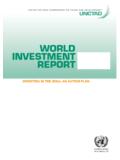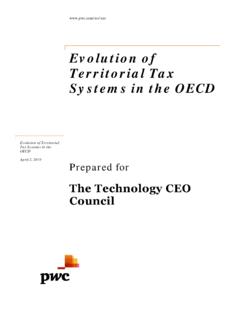Transcription of OECD Tax Policy Studies: Tax Effects on Foreign Direct ...
1 ISBN 978-92-64-03837-0 Tax Effects on Foreign Direct investment No. 17 Recent Evidence and Policy Analysis OECD 20079 Executive SummaryThe project underlying this publication on Policy considerations in the taxation of foreigndirect investment (FDI) has three main objectives. The first is to provide a review ofempirical studies of the Effects of taxation on FDI flows, aimed at better understandingwhat factors explain variations in estimates of the sensitivity of FDI to taxation. Thisreview is supplemented with an overview of various economic models used by policymakers to analyse possible tax Effects on FDI second objective is to report considerations relevant to the development of Policy inrelation to the tax treatment of inbound and outbound FDI, identified during a tour de tableroundtable discussion on the topic amongst OECD tax officials.
2 While perspectives andpositions vary from one country to another, to a large extent they are based on a commonbroad set of considerations including revenue requirements, efficiency (welfare)considerations, fair domestic competition concerns, and pressures to provideinternationally competitive tax third objective is to develop an approach for incorporating commonly-employed cross-border tax-planning strategies in effective tax rate models used to identify tax distortions toinvestment. This work would relax a number of restrictive assumptions adopted in a previousOECD publication, Taxing Profits in a Global Economy (OECD, 1991) reporting effective tax rates oncross-border Direct investment : non-intermediated ( Direct ) holding structures; fixed financialweights that may be unrepresentative in certain cases; immediate repatriation of profits; nomixing of Foreign tax credits in dividend credit systems to shelter Foreign interest or royaltyincome.
3 No account of hybrid instruments or hybrid for analysing tax Effects on FDITo guide tax Policy in relation to FDI, Policy analysts may rely on one or moreeconomic models or frameworks to examine possible channels of influence. A selection ofthese includes: the OLI framework; the OECD Policy framework for investment ; the neo-classical investment model, and models derived from the new economic the OLI framework, FDI decisions involve an assessment of ownership, locationand internalisation (OLI) conditions. Horizontal FDI involving production abroad can beexpected in place of exports or licensing where OLI conditions are met.
4 First, an MNE mustpossess ownership advantages (patents, know-how, trademark) conferring profit advantageover local firms in Foreign markets. Second, FDI must offer location advantages ( , labour or energy costs, low tax burden) that make local production more profitablethan exporting. Third, FDI must offer internalisation advantages that make undertaking abusiness activity directly through FDI more profitable than licensing to other firms inEXECUTIVE SUMMARYTAX Effects ON Foreign Direct investment No. 17 ISBN 978-92-64-03837-0 OECD 200710foreign markets the right to use assets conferring ownership advantage, for example bysafeguarding knowledge capital.
5 Vertical FDI decisions over locating or outsourcing certainstages of production to a Foreign location similarly centre around ownership, location andinternalisation Policy Framework for investment (OECD, 2005), targeted at Policy makers indeveloping and transition economies, proposes guidance in ten Policy fields including tax,in an effort to identify priorities and help develop effective policies. The tax chapter drawslargely on survey studies to identify key issues in weighing the pros/cons of corporate taxincentives and alternative tax policies and design options to attract FDI, while also raisingrevenue from FDI to help finance infrastructure setting the tax burden on inbound investment , Policy makers are encouraged toassess whether their host country offers attractive risk/return opportunities, taking intoaccount framework conditions ( stability; legal protection.)
6 Public governance), market characteristics (market size, availability/cost of labour, energy,state of infrastructure) and the prevalence of location-specific profits. As emphasised in thetax chapter, host country framework conditions and market characteristics depend in parton past and current levels of public expenditures on programs in areas of critical importanceto investors ( , infra-structure development). This link establishes the criticalimportance of collecting tax where possible on economic profit in order to finance publicexpenditures that strengthen host country fundamentals and attract the framework most widely used by public finance economists to analyse taxeffects on domestic and cross-border Direct investment is the neo-classical investmentframework.
7 A main attraction is its incorporation of main statutory tax parametersinfluencing capital costs and establishing the statutory tax burden on investment particular, parameter-based marginal and average effective tax rates (METRs/AETRs)derived from the neo-classical investment model may be analysed to determine thepercentage change to these tax burden measures resulting from a single or package ofcorporate tax Policy adjustments. When combined with empirical estimates of thesensitivity of FDI to these effective tax rates, the framework lends itself to estimating thelong-run Effects of corporate tax reform on the same time, such summary tax measures must be used with care as they ignorea number of factors influencing the actual tax burden on FDI ( ,administrative discretion in deciding tax liabilities, other taxes not captured by the model).
8 Some would also question, at least in certain cases, the central assumption of decliningmarginal productivity of capital. In particular, business concentrations may give rise toincreased rates of return (increasing returns to scale at the industry level), with possiblyvery different Policy predictions of the neo-classical theory of investment as regards tax Effects oninvestment have been challenged in recent years by the new economic geographyframework, emphasising the role of self-reinforcing business concentration(agglomeration) economies. Under the core-periphery (CP) model, market access effectsmay dominate and create incentives for firms to locate production in large markets, toreduce transportation costs, and to export to small markets.
9 With firms profiting fromconcentration economies, a degree of inertia is predicted in the location choice of firms,implying a degree of fixity of economic profits that can be taxed up to some point withoutdiscouraging SUMMARYTAX Effects ON Foreign Direct investment No. 17 ISBN 978-92-64-03837-0 OECD 200711In a standard neo-classical investment model where capital stocks are adjusted suchthat after-corporate tax rates of return are equalised across locations, an increase in the taxrate in country A would cause capital to relocate from country A, causing pre-tax rates ofreturn in A to rise, and in other countries to fall, until after-tax rates of return are againequalised.
10 In contrast, under a CP model, the same tax rate increase may not lead tosignificant capital relocation if business concentration benefits of country A more thanoffset the higher tax burden. However should country A increase its tax rate significantly,business concentration economies may be more than outweighed by a higher tax burden,causing capital to relocate from country A. Business concentration economies imply thateffects of tax rate changes will be non-linear Policy adjustments under certain conditionsmay have minimal impact on the location of capital, while subsequent adjustments mayhave dramatic Effects . Thus the response of capital to past reforms may offer a poor guideto gauge the impact of similar reforms, and the (common)












